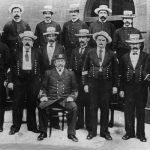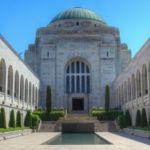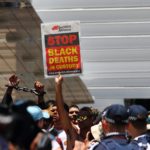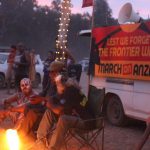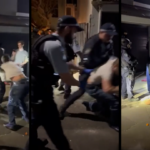The Law Enforcement Problem for First Nation’s People in NSW Escalated When Organised Policing Started
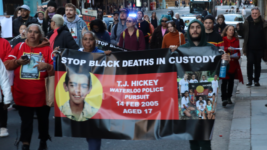
When the British colonised what is now referred to as the state of NSW, the First Peoples of the land, whether that be Gadigal, Dharug or Gumbaynggirr, to name a few, didn’t have police forces and nor did they have prisons, after living cohesively for tens of thousands of years.
However, today, a little over 230 years after the British Crown staked its claim over Warrang-Sydney to establish what came to be known as the colony of NSW, First Nations people make up 30 percent of the state adult inmate population, whilst only accounting for 3.4 percent of the general populace.
This indicates the stark systemic racism inherent in the NSW criminal justice system and its law enforcement arm, which, when established in 1825, consisted of the NSW military mounted police that was created to deal with Indigenous people, prior to being replaced by a civilian iteration in 1850.
Border police were introduced in the 1830s, with the NSW mounted native police rolled out in the late 1840s, and these separate law enforcement bodies were amalgamated to form what we have today, the NSW Police Force, in 1862.
Right now, NSW police, with its over 17,600 officers, is one of the largest law enforcement bodies on the planet.
So, while the recent lethal tasering of an elderly woman, along with the police having shot dead two others having mental health episodes, have bolstered ongoing calls for police reform around drug dog and strip search use, for the First Peoples of the region, NSW police has always been a problem.
Settler colonial policing
Australia is and always has been a settler colonial state, similar to the USA, Canada and Israel. This means that colonisers take over an entire landmass to permanently settle there, with the attempted extermination of the First Peoples, in other words, genocide, being used to facilitate the project.
This is evidenced by the 1816 directive issued by then NSW governor Lachlan Macquarie, which ordered soldiers, prior to police rollout, to move westwards from Sydney into the interior to capture Aboriginal people, and if any resisted, they were to shoot them and hang their corpses from trees.
And less than a decade later, when the NSW military mounted police was formed in response to Frontier War clashes between First Peoples attempting to defend their land against British invaders, local law enforcement was charged, in its inception, with killing and controlling Indigenous peoples.
But much has changed globally over the time since the colonisation of this continent began: slavery has been abolished and universal human rights have been acknowledged and so too, has the ability of European colonisers to continue their blatant attacks on Indigenous peoples been curbed.
Yet, in NSW, as in every other part of the country, police continue to treat First Nations people with contempt, whether that be with overpolicing, deciding to criminally proceed against them when it’s at an officer’s discretion, or in killing them and walking away from the incident scot-free.
Bias in policing
The Bureau of Crime Statistics and Research (BOCSAR) is an agency responsible for reporting on crime rates, correctional systems and criminal justice in NSW, and it often inquires specifically into how these systems affect Aboriginal people, in recognition of the disparities they face under them.
And in a June report, the agency considered the NSW cannabis cautioning scheme, which, since 2000, has permitted police officers to use discretion on whether to issue adults found with a small amount of cannabis with a caution, rather than officially charge them with the offence of possession.
Researchers tracked how NSW police had been issuing cannabis cautions between January 2017 and February 2020 to see whether there were any significant differences in the way officers were applying these laws to Aboriginal adults compared to their non-Indigenous counterparts.
What the bureau found was only 11 percent of Aboriginal people found in possession were eligible for a caution, while 44 percent of non-Indigenous people were, which indicates that this diversionary scheme was established with an eligibility criteria that discriminates against First Nations people.
And further, when police were able to issue a caution to those found in possession of an amount of the drug, only 40 percent of Aboriginal adults were let off without punishment, while 74 percent of non-Indigenous people were cautioned, which reveals the prejudice in the NSW police culture.
Police brutality and custodial deaths
The National Deaths in Custody Monitor indicates that over the year 2021-22, there were five First Nations deaths in NSW police custody or custody-related matters, making it the highest number in a single year since 1989-90 when recording began.
Gomeroi man Stanley Russell was shot five times in his aunt’s home in Sydney’s west in November 2021. After four officers turned up to arrest him, Russell, who had an intellectual disability, appeared holding a knife and an axe, and two officers shot him five times.
Whilst February 2022 saw Dunghutti teen Jai Wright die in hospital after he collided with an unmarked police car in Sydney’s South Eveleigh in circumstances involving police pursuing some teenagers in the area at the time, but reports remain sketchy as to whether they were chasing him.
The June 2020 Black deaths in custody rally that saw tens of thousands of Sydneysiders march through the city was calling for an end to such killings, but it also had a focus on the daily brutality that state law enforcement readily metes out towards First Nations people.
Just days prior to the protest taking place, a NSW police constable, who was having a verbal spat with a couple of First Nations teenagers, decided he’d grab a 16-year-old, pin his elbows behind him, before kicking out his legs and dumping him face first onto the brick path he was standing on.
In March 2021, following a series of high-profile Black Lives Matter protests having taken place in Sydney, which highlighted the issue of police brutality, two male police officers came across two female First Nations teens sitting on the side of the road in a backstreet in Darlington.
The two women had stopped because Anaiwan and Biripi woman Tarneisha Widders was having a panic attack. However, moments after the officers showed up, one had the young woman by the throat pushed up against the gate she was resting upon, and backup officers had been called in.
The prejudice that NSW police, and law enforcement the entire country over, takes to First Nations people whilst policing them is so ingrained in the culture that officers at times don’t seem fully aware that they’re so extreme in their disproportionate dishing out of violence.
That 547 Aboriginal deaths in custody have taken place nationwide since 1989-90, yet not one police or corrections officer has been convicted in relation to any, shows that despite conveying that action is being taken to improve policing bias, it continues on in the same manner as it always has.
And a clear reminder of this is that the National Justice Project was teaching Aboriginal children in western Sydney about how to use an app on their phones to film police harassing them in March this year, which indicates serious policing issues when kids have to be warned against them.
Indeed, NSW police continues to run the STMP (Suspect Target Management Plan), which permits officers to place individuals, who they suspect are likely to commit crimes, on a secret blacklist, even if they’ve never been charged with a crime before, and then subject them to extra surveillance.
A 2017 report into the scheme found that data from five NSW police local area commands over the period of two years, revealed that 54 percent of people on the list were First Nations individuals, despite the small proportion of the general public they account for.
So, while recent casualties have led to calls upon the Minns government to engage in reforming the broad reach of the NSW Police Force, the intrinsic racial prejudice the institution has been founded upon probably warrants a much deeper approach than a simple amendment bill can forge.


